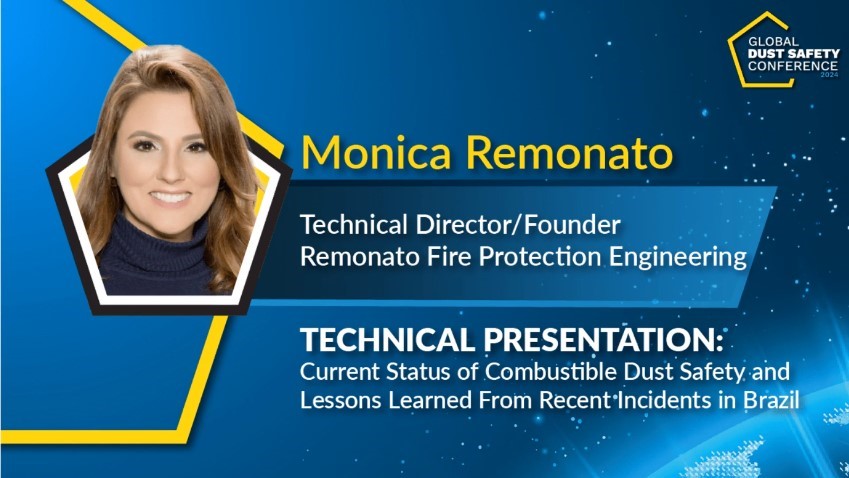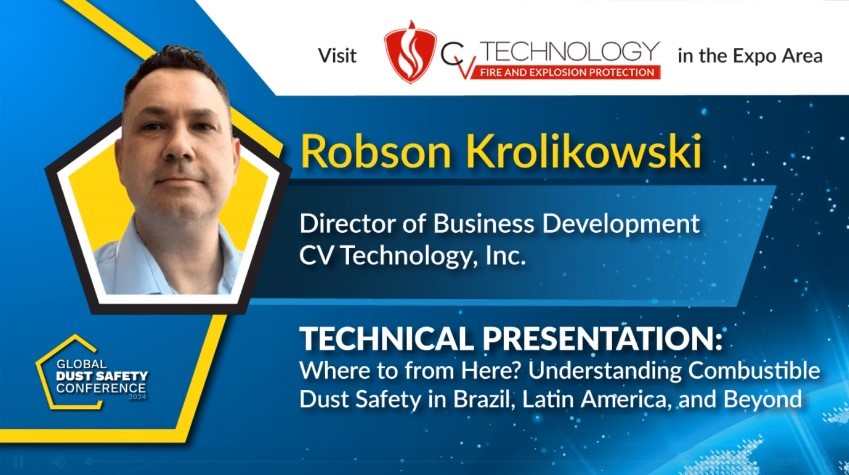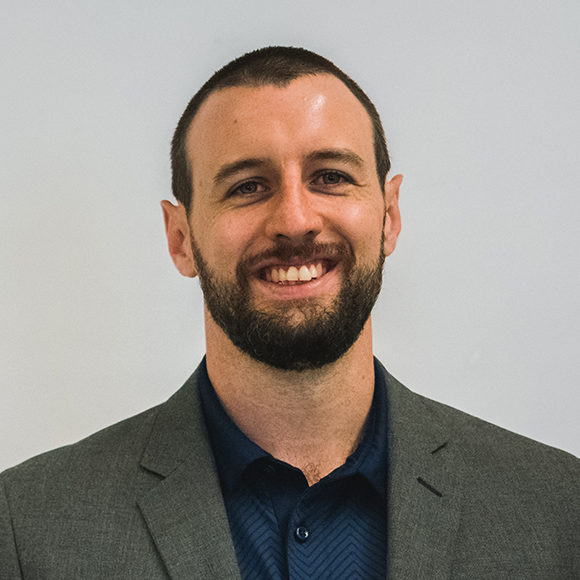Updated November 7, 2024 Authors: Dr. Chris Cloney and Jon Barrett of Dust Safety Science

Introduction to Combustible Dust Incidents in Brazil
In recent years, Brazil has faced a concerning trend of combustible dust incidents, posing significant risks to industrial workers and facilities. These incidents, ranging from fires to explosions, have led to injuries, fatalities, and substantial property damage. Addressing this issue requires a comprehensive understanding of the causes, and implications associated with combustible dust. In this article, we delve into the complexities of combustible dust incidents in Brazil, examining their root causes, impact, and strategies for risk mitigation. Combustible dust incidents in Brazil are also covered in What are the Challenges to Combustible Dust Safety in South America?
Understanding Combustible Dust and Dust Explosions
Understanding what combustible dust is and why it poses a significant hazard in industrial settings, is a crucial first step in preventing combustible dust explosions and combustible dust incidents. Combustible dust refers to fine particles or powders that accumulate during various manufacturing, processing, or grain silo, handling operations. These particles can originate from a wide range of materials, including metals, plastics, grains, and chemicals.
When dispersed in the air in high concentrations, and with oxygen and an ignition source present, combustible dust becomes highly explosive. Even a small spark or heat source can ignite the dust cloud, leading to a rapid combustion reaction mixing with oxygen known as a deflagration. The force generated by such an event can cause devastating explosions, destroying entire facilities and endangering workers’ lives.
The Scale of the Combustible Dust Incidents in Brazil
The scale of combustible dust incidents in Brazil is alarming, as evidenced by statistics compiled from various sources. According to Monica Remonato, an Engineer with Remonato Engineering based out of Curitiba, Brazil, Brazil has experienced a dust-related fire or explosion approximately every 9.5 days over the past four years. These incidents have occurred across different industries, including food processing, woodworking, and chemical manufacturing.
One of the most recent and tragic incidents occurred at a feed factory in Jaguapitã, Paraná, where an explosion resulted in the loss of one worker’s life and severe injuries to two others. While the exact cause of the explosion is still under investigation, initial reports suggest that combustible dust may have played a significant role.
In another recent incident, at least eight people were killed and nearly a dozen were injured after a grain silo explosion in the city of Palotina, Parana State, Brazil, occurred on July 27, 2023. The grain silo where the explosion and white smoke occurred stored about 12,000 metric tons of soybeans and 40,000 metric tons of corn.
A previous combustible dust explosion, Two Workers Injured When Welding Spark Ignites Dust Explosion in Brazil, in November 2022. At the time of the explosion, the two workers were performing welding work on some metal structures. It is believed that a welding machine spark ignited the explosion. An additional source of a combustible dust incident in Brazil includes Silo Blast in Southern Brazil Kills at Least Eight, One Missing
Combustible dust incidents, continue to occur worldwide and in many industries, as presented in this combustible dust research and incident database from Dust Safety Science. Over 120 combustible dust incidents have occurred just in the last 5 years, in Brazilian states.

Root Causes of Combustible Dust Incidents in Brazil
Several factors contribute to the accumulation and ignition of combustible dust in industrial environments. Understanding these root causes is crucial for implementing effective prevention measures. Some common factors for dust safety importance include:
- Costs: Monica Remonato during a Dust Safety Science Podcast stated that pricing is often an issue when buying dust safety equipment in Brazilian states. “The taxes are really high. We don’t have a Brazilian industry that can make this spark detector or that fire suppression system. I don’t know why the taxes are so high. So this is the real challenge: the price.” She expressed hope that as awareness increases, some vendors will start manufacturing in Brazilian states and, hopefully, make their equipment more affordable in that country.
- Awareness and Education: Effective and specifically tailored education and training programs are essential for equipping workers with the knowledge and skills to identify, prevent, and respond to combustible dust hazards and dust management. To overcome language barriers, it’s imperative to adopt a multi-pronged approach. This involves translating safety resources, training materials, and signage into local languages and dialects prevalent in industrial regions.
- Inadequate Housekeeping: Failure to properly clean and maintain work areas can lead to the accumulation of combustible dust particles on surfaces and in grain silos. Dust buildup on surfaces, equipment, and ventilation systems increases the risk of a dust cloud and explosion.
- Ventilation Maintenance: Inadequate ventilation systems allow dust particles to remain suspended in the air, creating an environment conducive to explosions. Proper ventilation is essential for controlling dust concentrations and preventing the formation of explosive mixtures.
- Equipment Malfunction: Malfunctioning machinery or equipment can generate sparks or heat, igniting nearby dust accumulations. Regular maintenance and equipment inspection are essential for identifying and addressing potential ignition sources, oxygen levels, and white smoke.
- Static Electricity: Static electricity can accumulate on surfaces and materials, especially in dry environments, such as a grain silo. When discharged, static electricity can ignite combustible dust clouds, leading to explosions. Implementing static control measures is critical for mitigating this risk.
- Ignition Sources: External ignition sources, such as open flames, hot surfaces, electrical sparks, and frictional heat, can trigger combustible dust explosions. Identifying and eliminating potential ignition sources is essential for preventing accidents.
Impact of Combustible Dust Incidents in Brazil
The consequences of combustible dust incidents can be severe, affecting human lives and economic stability in Brazilian states. Combustible dust explosions often result in injuries and fatalities among workers. The loss of life not only devastates families and communities but also raises concerns about workplace safety and regulatory compliance. Monica Remonato’s presentation covered open challenges related to education, fire safety, and explosion protection as well as lessons learned from recent explosion incidents. Some of the key impacts of combustible dust incidents of importance are:
- Explosions and fires caused by combustible dust can cause extensive damage to industrial facilities, equipment, and infrastructure. The cost of repairs and rebuilding can be substantial, impacting businesses and local economies in Brazilian states.
- Combustible dust incidents may release harmful pollutants, white smoke, and toxins into the environment, posing air and water quality risks. Cleanup and remediation efforts are necessary to mitigate environmental damage and protect ecosystems.
- Companies found liable for combustible dust incidents may face legal action, fines, and penalties. Moreover, insurance premiums may increase, and investors may reconsider their support for businesses with a history of safety violations.

Combustible Dust Preventive Measures and Best Practices
Mitigating the risks associated with combustible dust requires a multi-faceted approach encompassing engineering controls, administrative measures, and worker training. Conducting a thorough hazard assessment to identify areas prone to dust accumulation and potential ignition sources is the first step in mitigating risks. Understanding the specific hazards present in the workplace allows for targeted interventions. Robson Krolikowski, the Director of Business Development at CV Technology, presented “Understanding Combustible Dust Safety in Brazil, Latin America, and Beyond,” at the Dust Safety Science Conference. Some of the safety measures of the importance of dust management include:
- Housekeeping Practices: Implementing regular cleaning schedules and housekeeping procedures helps minimize dust accumulation in work areas and dust management. Using vacuum systems equipped with HEPA filters and wet cleaning methods can effectively remove dust without dispersing it into the air.
- Ventilation Systems: Installing and maintaining effective ventilation systems is crucial for controlling dust concentrations and preventing the formation of explosive atmospheres. Local exhaust ventilation and dust collection systems should be designed to capture and remove dust at the source.
- Equipment Design and Maintenance: Selecting equipment and machinery with built-in safety features, such as spark detection and explosion suppression systems, can help reduce the risk of ignition. Regular inspection, maintenance, and repair of equipment, such as a grain silo, are essential for ensuring their safe operation.
- Static Control Measures: Implementing static control measures, such as grounding and bonding, prevents the accumulation of static electricity on surfaces, equipment, and materials. Conducting static audits and implementing static dissipative materials can further minimize the risk of electrostatic discharge.
- Ignition Source Control: Eliminating or minimizing potential ignition sources, such as open flames, hot surfaces, and electrical equipment, reduces the likelihood of dust explosions. Implementing hot work permits, using intrinsically safe electrical devices, and enforcing smoking bans are effective strategies for controlling ignition sources.
- Training and Education: Providing comprehensive training and education to workers on the hazards of combustible dust, dust management, safe work practices, and emergency response procedures is essential for promoting a culture of safety. Workers should be aware of the risks associated with their tasks and equipped with the knowledge to prevent accidents.
- Emergency Preparedness: Developing and implementing emergency response plans, including evacuation procedures, communication protocols, and firefighting strategies, ensures a timely and effective response to combustible dust incidents. Conducting regular drills and simulations prepares workers for handling emergencies and minimizing their impact.

Conclusion
The prevalence of combustible dust incidents in Brazil underscores the urgent need for proactive measures and dust management to enhance workplace safety and mitigate risks. The statistics reveal a disturbing trend, with the country experiencing a dust-related fire or explosion approximately every 9.5 days over the past four years. These incidents not only result in injuries, fatalities, and property damage but also have broader economic and environmental consequences from white smoke. Addressing the root causes of combustible dust, dust management, implementing preventive measures, and fostering a culture of safety are critical steps toward reducing the frequency and severity of such incidents.
Brazil has experienced a concerning frequency of combustible dust incidents, highlighting the urgent need for improved safety practices across various industries. Between July and August, numerous incidents have been attributed to combustible dust explosions, often involving sectors with high dust generation, such as agriculture and food processing. Firefighters and investigators are frequently called to these scenes, where thorough investigations reveal the root causes and offer insights into prevention. Published reports from these incidents emphasize the importance of a proactive approach to dust management, underscoring the critical role of hazard assessments and employee training in reducing dust-related risks.
One incident occurred in a manufacturing tunnel where dust accumulation led to a significant explosion, impacting several people and causing extensive damage. The response efforts demonstrated the bravery and skill of Brazil’s firefighters, who worked tirelessly to control the flames and prevent further escalation. This incident is a valuable case study, based on which safety professionals have identified key lessons learned. By addressing issues such as dust accumulation and ventilation within enclosed spaces, industries can take meaningful steps to mitigate the risk of combustible dust explosions.
To combat the risks associated with combustible dust, industry stakeholders, regulatory bodies, and policymakers must collaborate to develop and enforce robust safety standards and regulations and dust management. Resources such as the Brazilian Association of Occupational Hygiene provide valuable guidance and best practices for managing combustible dust hazards. Additionally, research institutions and academic organizations play a vital role in advancing our understanding of explosion dynamics and developing innovative mitigation strategies.
About Dust Safety Science
Dr. Chris Cloney, of Dust Safety Science, provides additional Combustible Dust Incidents in Brazil information, with a Podcast. Click on these Podcast Links: Combustible Dust Safety in Brazil and 2020 Conference Review with Monica Remonato and Dust Explosion Prevention and Protection in Brazil with Jay Juvenal

Resources:
Visit: Latin America Dust Explosion Safety and Dust Hazard Analysis Demystified Online Training
Visit: Dust Safety Science’s Training Page
Visit Dust Safety Science (Global Incident Tracking)
Visit Dust Safety Academy (Resources, Training, and Events)
Visit Dust Safety Professionals (Need Help? Get Support Today!)
Visit Dust Safety Journal for the Dust Safety Science Monthly Journal
Subscribe to our Dust Safety Science Newsletter at Dust Safety Science Newsletter
Visit the Dust Safety Science blog for written articles on combustible dust safety including the latest research, expert opinions, and state-of-the art fire and explosion protection.
